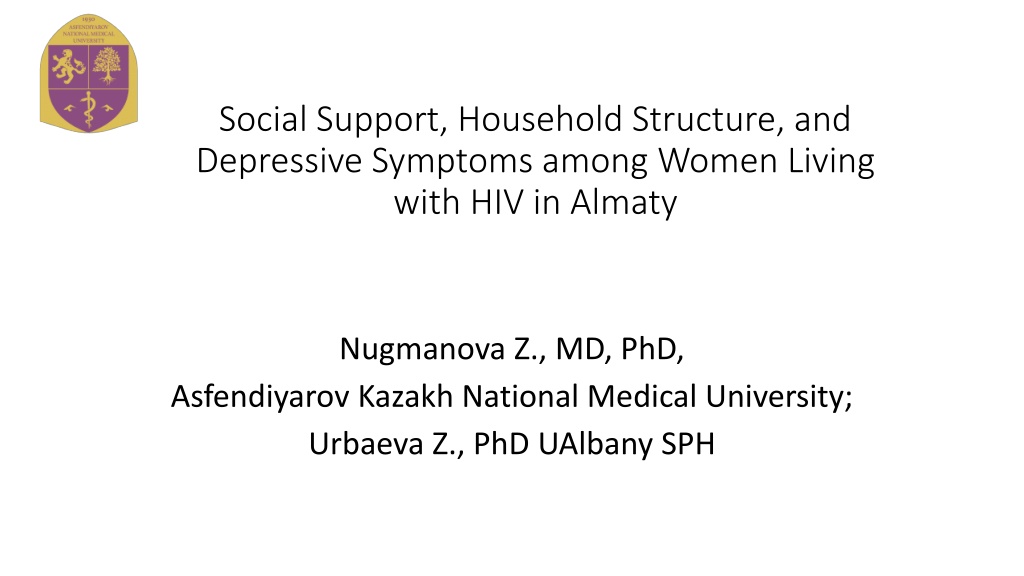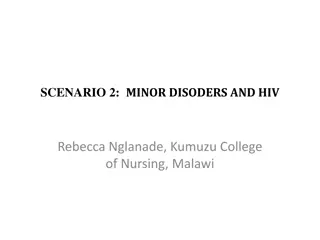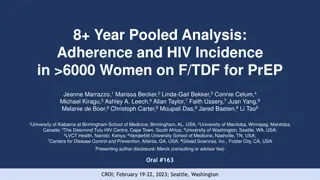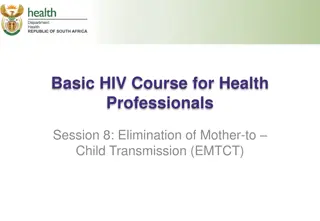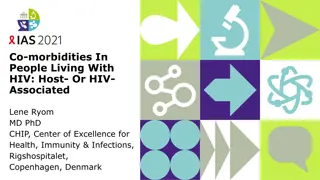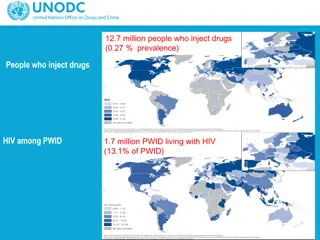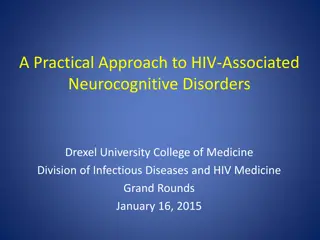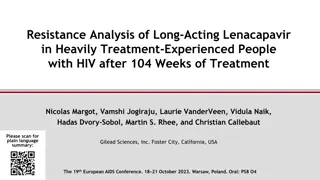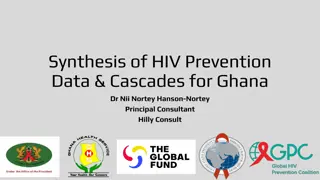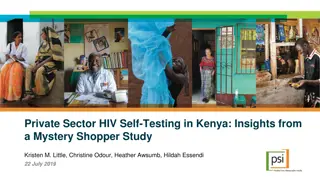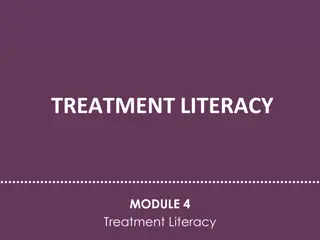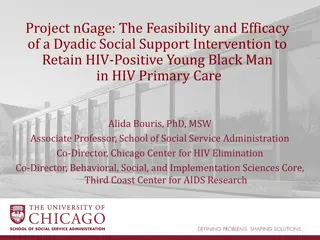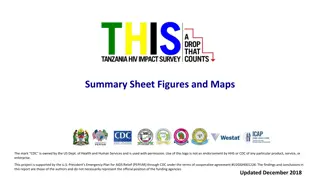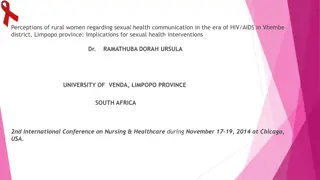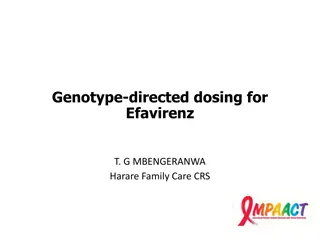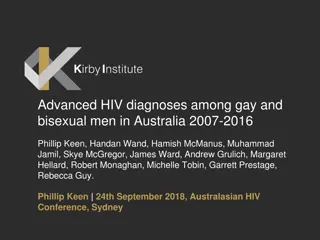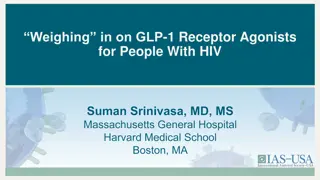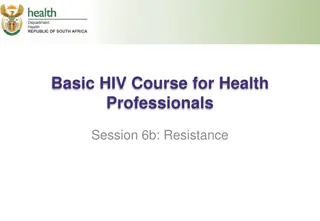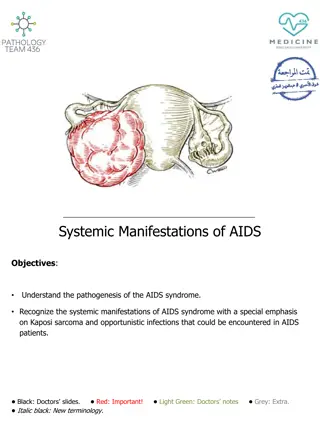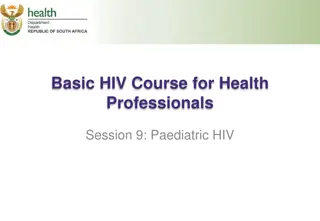Factors Influencing HIV Women in Almaty
Study explores social support, household structure, and depressive symptoms among women living with HIV in Almaty, Kazakhstan. It discusses HIV statistics in the region, modes of transmission, gender distribution, and engagement in ART services. Conceptual model outlines determinants of engagement in ART, including structural, social, economic conditions, health systems, individual factors, and biomedical considerations.
Download Presentation

Please find below an Image/Link to download the presentation.
The content on the website is provided AS IS for your information and personal use only. It may not be sold, licensed, or shared on other websites without obtaining consent from the author. Download presentation by click this link. If you encounter any issues during the download, it is possible that the publisher has removed the file from their server.
E N D
Presentation Transcript
Social Support, Household Structure, and Depressive Symptoms among Women Living with HIV in Almaty Nugmanova Z., MD, PhD, Asfendiyarov Kazakh National Medical University; Urbaeva Z., PhD UAlbany SPH
HIV in Kazakhstan (National AIDS Cr Data) HIV is growing in Eastern Europe and Central Asia, including Kazakhstan As of June 30, 2019, the total number of HIV cases was 37 616 people, of which 34 836 were citizens of the Kyrgyz Republic; PLWHA - 23,799 For 12 months of 2018, the proportion of women was 38% A decrease in the parenteral mode of transmission with intravenous drug use was 2.4 times (from 72% to 30%), the sexual mode of transmission increased 3 times (from 20% to 62%)
3 HIV in KZ (2006-2016): Modes of Transmission (AIDS Cr Data) 72 56 60.5 60.3 66.7 65.4 58.5 57.7 55.7 61 50 46.2 35 39.7 28.4 40.4 33.8 33 32.5 24.5 30 18 3.9 2.9 1.7 1.4 1.25 0.93 0.8 0.79 0.57 0.5 0.45 2006 2007 2008 2009 2010 2011 2012 2013 2014 2015 2016
4 HIV in KZ (2006-2016): Gender Distribution (AIDS Cr Data) 25 29 30 33 35 37 40 42 42 43 44 75 71 70 67 65 63 60 58 58 57 56 2006 2007 2008 2009 2010 2011 2012 2013 2014 2015 2016
Engaging in ART services Myer and Phillips, who studied ART adherence among women postpartum, proposed the term Engaging in ART Services to reflect related phenomena: ART adherence and retention in care services (Myer & Phillips, 2017). To a certain extent, this approach can be extended to all women living with HIV in general.
Conceptual model: determinants of engagement in ART services for women (Myer & Phillips, 2017). 1. Structural, social and economic conditions in regions where HIV is prevalent. Health systems and services: the availability and accessibility of health services, as well as the quality of service and service delivery models. Factors at the individual level, including partnerships and social relationships, disclosure of HIV status, social support and / or mental health. Biomedical factors: problems associated with HIV and / or ART (for example, side effects of ARVs). 2. 3. 4.
Factors at the Individual Level Factors affecting women's participation in ART services on an individual level (interpersonal relationships or psychosocial problems) are important, although these factors are often strongly influenced by structural and / or biomedical conditions. Depression or other mental health problems, for example, can affect women's ability to adhere to ART, and the determinants of mental health can include both social conditions and biological processes.
Psychosocial Determinants of Mental Health Psychosocial determinants are an important risk factor and protective factor for mental health. Many studies have found an inverse relationship between social support and symptoms of depression among people living with HIV, There are few such studies in Kazakhstan At the same time, in our region, the family is an important social institution based on collectivist values, which determine both the socialization systems and the support systems available to women through relatives Understanding the relationship between social support, household structure, and mental health issues can help design interventions.
General Information: Depression Mental health is a key factor in the quality of life of people in general, PLHIV in particular The relationship between depression / anxiety and HIV is probably bi-directional PLHIV have a higher risk of developing mental illness Increased psychological stress due to HIV diagnosis and stress of living with HIV Social side effects of HIV associated with mental illness, including low levels of social support, feelings of isolation, and discrimination People living with mental illness are more likely to engage in risky behaviors for HIV infection: Unprotected sex, use of surfactants and the presence of several sexual partners
General Information: Depression and PLWH General Information: Depression and PLWH Depression is a risk factor for the progression of HIV infection. Depression is associated with A decrease in the number of CD4; Slow virologic suppression; HIV mortality; Faster progression to AIDS; Mortality from all causes among PLHIV. Depression is a risk factor for poor ART adherence Estimates of the prevalence of depression among PLHIV vary widely depending on the measure, sample, and country.
General Information: The Role of Social Support Social support can be defined as the presence of people on whose care and love you can rely Social support is a supporting factor for: - commitment to ART - changes in risk behavior - general health Social support is a protective factor for mental health because it is associated with a reduction in depressive symptoms among women living with HIV.
Methods: Inclusion Criteria Patients who were registered at the Almaty City AIDS Cr were invited from April to October 2018 to participate in the study. Inclusion Criteria: - Women - age 18 years - Laboratory-confirmed HIV infection, - Knowledge of Kazakh or Russian - Not intoxicated while visiting the Center
Methods. Depression: Patient Health Questionnaire-8 (PHQ-8) The eight items in PHQ-8 directly correspond to the criteria for the Diagnostic and Statistical Manual of Mental Disorders V (DSM-V) for depressive disorders, excluding suicidality. A score of 10 or more is used to measure current depression in population studies.
Measure: Depression Patient Health Questionnaire (PHQ - 8) Major depressive disorder Other depressive disorder Symptoms over the last 2 weeks Necessary symptoms: 1. Little interest of pleasure in doing things 2. Feeling down, depressed or hopeless At least 1 At least 1 More that half of the days OR nearly every day Other Symptoms: 3. Trouble falling or staying asleep, or sleeping too much 4. Feeling tired or having little energy 5. Poor appetite or overeating 6. Feeling bad about yourself or that you are failing or have let yourself or your family down 7. Trouble concentrating on things, such as reading the newspaper or watching television 8. Moving or speaking so slowly that other people could have noticed? Or opposite being so fidgety or restless that you have been moving around a lot more then usual At least 4 1 to 3 symptoms More that half of the days OR nearly every day
Methods. Social Support: A Multi-dimensional Scale of Perceived Social Support (MSPSS) Perceived social support was measured using an approved multi-dimensional 12- point scale that measures women's perceptions of available social support in three dimensions: (a) family; (b) friends; (c) significant others. In addition, a household structure was defined (female-headed households, male- headed households, and kinship-based households). Logistic regression was used to measure the relationship between social support and the household structure with depression, taking into account demographic characteristics. The study was approved by the research ethics committee of KazNMU. Surveys were conducted after obtaining informed consent from women who decided to participate.
Measure: Multidimensional Scale of Perceived Social Support (MSPSS) Family sub-scale My family really tries to help me I get the emotional help and support I need from my family. I can talk about my problems with my family. My family is willing to help me make decisions. Friends sub-scale My friends really try to help me I can count on my friends when things go wrong I have friends with whom I can share my joys and sorrows. I can talk about my problems with my friends Significant other sub-scale There is a special person who is around when I am in need There is a special person with whom I can share joys and sorrows I have a special person who is a real source of comfort to me There is a special person in my life who cares about my feelings
Demographics (n=410) AGE Language Percent Percent 70 70 60 60 50 50 40 40 30 30 20 20 10 10 0 0 18-29 30-39 40-49 50+ Russian Kazakh Rus/Kaz Other
General health and livelihoods (n=410) General Health Self Assessment # of Poor Health Days Percent Percent 60 60 Physical 50 50 Mental Health 40 40 30 30 20 20 10 10 0 0 None 1-3 days 4-7 days 8-14 days 15+ days Excellent Good Fair Poor/Very Poor
Indicator: Multidimensional Scale of Perceived Social Support (MSPSS) Support of Significant Other Family Support Friend Support 60 60 60 50 50 50 40 40 40 30 30 30 20 20 20 10 10 10 0 0 0 Low Medium High Low Medium High Low Medium High
Results Of the 410 WLWH, 17.5% had a score of PHQ-8> 10 (current depression). In all types of households, women with higher levels of social support were less likely to report depression. Based on the regression analysis, support of family and friends was associated with a 35% (OR = 0.65; p <0.05) and 22% (OR = 0.78; p <0.05) decrease in the chances of depression by one unit of increase in family and friends support, respectively. Compared to male-headed households, the chances of depression were significantly higher among women living in female-headed households (OR = 2.33; p <0.05) and kinship-based households (OR = 2.02; p = 0.06).
Conclusion Given the sociocultural context of family life in Kazakhstan, we have determined that marital status is important for the psychological well-being of women. Single women living with HIV can receive lower levels of support, which can negatively affect their mental health. On a broader level, women may not receive enough support from their husbands, but marriage seems to be positively related to their psychological well-being. These data emphasize the importance of psychosocial interventions for the treatment of depression among PLHIV in Kazakhstan. The sociocultural context should be considered when designing effective interventions.
Acknowledgement NYS International Research Training Program (NYS-ITRP), Almaty City AIDS CR Leadership L-A McNutt, PhD; J.Urbaeva, PhD, SPH U lbany KazNMU and Almaty AIDS Cr colleagues participating in interviewing women living with HIV
